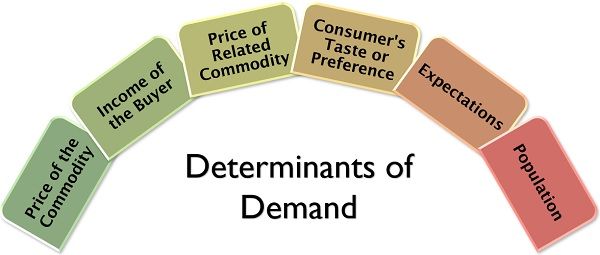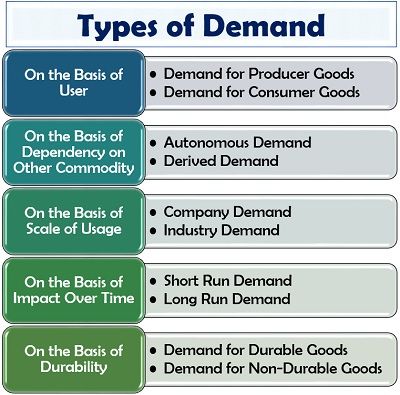Definition: Demand in economics can be defined as the quantity of a commodity which a customer who is willing and capable of paying for it, wants to acquire at the given market price within a given period. It acts as a base for the production of goods and services. A business forecast its sale and estimates the potential market by the demand which a product creates in the market.
Demand for a commodity comprises of the following:
- Desire for a Commodity: To create demand, the customer must initially develop a need or want to buy a particular product.
- Ability to Buy: He must have the paying capacity or purchasing power to acquire that commodity.
- Willingness to Pay: Only desire and ability to pay are not enough; one must have the willpower to spend his money on buying the commodity.
- At Given Price: The customer has to agree with the market price of the commodity to demand it.
- In Given Time: The commodity must be purchased within a particular period.
For Example; A person has the desire to buy a car, he is able and willing to pay for it, but he waits for some offer or discount over it. Therefore, it cannot be termed as his demand today.
Content: Demand in Economics
Determinants of Demand in Economics
Demand is never static; it keeps on varying from time to time. There are majorly six factors which affect the need for a commodity.
These are explained in detail below:

Price of the Commodity
The demand for a particular product is adversely affected by its price. When the price of a commodity rises, its demand decreases. And when the price of a commodity falls, its demand increases.
Income of the Buyer
If the income of a customer in monetary term increases, his purchasing power also increases. Now he can buy more of a particular commodity than before, ultimately leading to a rise in the demand for goods; and vice versa.
Price of Related Commodity
Price of a related commodity can be bifurcated into the following:
Price of Substitute Commodity: Substitute goods are the products which can replace a particular commodity owing to similar usage. For Example; Rice and bread.
If the price of a substitute good increases, the demand for the commodity increases. If the price of the supplementary product decreases, the demand for the commodity also falls.
Price of Complementary Commodity: Goods that go hand in hand are known as the complementary commodities. For Example; Electrical appliances and electricity.
If we consider electrical appliances as our commodity, then electricity is termed as a complementary good. When the price of electricity rises, the demand for electrical devices fall, and when the price of electricity drops, the demand for electrical appliances boosts up.
Consumer’s Taste or Preference
The consumer’s choice influences the demand for a commodity. If the consumer prefers a particular product more, the demand for that commodity increases; and vice-versa.
Expectations
Future price fluctuations and predictions also create an impact on a commodity’s demand. If the price of a particular product is assumed to rise shortly, its demand will increase today and vice-versa.
Population
When the population of a place rises, the demand for a commodity automatically goes up and falls with the decrease in the population.
Types of Demand in Economics
The demand for a commodity is classified in various kinds in economics by the user of that commodity, dependency on another product, the scale of demand, its impact over time and durability.
Let us now understand each kind of demand one by one:

Based on User: The first category bifurcates demand by the end-user of a commodity as follows:
- Demand for Producer Goods: It is the demand for a commodity which is used in the manufacturing of other products by the industries, factories and manufacturing units.
For Example; raw material, tools, land, plant, equipment and machinery - Demand for Consumer Goods: The demand for finished products by the consumers for final usage is known as demand for consumer goods.
For Example; grocery products, cosmetics, cars, etc
Based on Dependency on Other Commodity: The demand for a particular commodity may be influenced by the demand for related products. This relation can be better understood below:
- Autonomous Demand: Some commodities creates an independent demand in the market. These are hardly influenced by the demand for other products.
For Example; mobile phones, apparels, vehicles, etc. - Derived Demand: The demand for any commodity which acts as an intermediate or adds to the production of another product is called derived demand.
For Example; sim cards are in demand because of mobile phones; apparels create a demand for textile goods, petrol is in need due to vehicles, etc.
Based on Scale of Usage: The demand for a commodity can be determined by the scale of its usage. These can be categorised as follow:
- Company Demand: The demand for a product by a single manufacturing unit or company or organisation is called a company demand.
For Example; demand for Eicher trucks by ‘ABC Transport’ company - Industry Demand: When the demand for all the companies belonging to a particular sector or industry is pooled together, it is termed as industry demand.
For Example; The demand for Eicher trucks by all the transport companies is seen as its demand for the whole transport sector.
Based on Impact Over Time: The commodity’s demand fluctuates by various determinants like price, income, and so on. Taking this into consideration, the following two kinds of demand are generated:
- Short Run Demand: The demand for commodity changes in the short run with the immediate difference in its price or other variables.
For Example; if the price of gold rises in the short run, people will prefer not to buy it till the prices fall, ultimately the short-run demand for gold will decrease. - Long-Run Demand: The change in the factors deriving the demand of a particular commodity over the long run, may lead to the permanent switching of the customers from one product to another. Or they may adjust to the prevailing market conditions.
For Example; if a particular telecom service provider rises the tariffs, people may switch to the services offered by other service providers.
Based on Durability: The demand for commodities can be segregated as per their vulnerability or usage over a period as follows:
- Demand for Durable Goods: Commodities which are of fixed or capital nature and once purchased can be used for an extended period are considered to be durable goods.
For Example; laptop, furnace, factory building, etc - Demand for Non-Durable Goods: Goods which are consumed in a short interval or perishable are called non-durable goods.
For Example; FMCG products, petrol, raw material, etc
Most of the critical investment and expansion decisions are based on the customer’s demand for a particular commodity.
If there is no demand for a product, the business unit would not take any interest in manufacturing that product. Therefore, demand forecasting is done by organizations before preparing for their production.
Leave a Reply